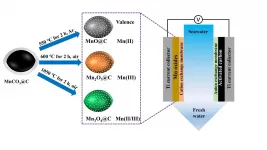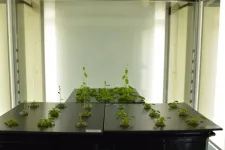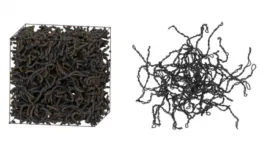INFORMATION:
Direct evidence of segregated oceanic crust trapped within the mantle transition zo
2021-05-28
(Press-News.org) Professor YAO Huajian's research group from the School of Earth and Space Sciences of the University of Science and Technology of China (USTC), in cooperation with Dr. Piero Poli from Grenoble-Alpes University of France, combined the unique resolution reflected body waves (P410P and P660P) retrieved from ambient noise interferometry with mineral physics modeling, to shed new light on transition zone physics. Relevant work was published in Nature Communications.
The subduction of oceanic slabs is an important process of the earth's internal material circulation. Studying the recycling of oceanic crust in the deep mantle can provide crucial clues for understanding mantle dynamics and circulation of deep materials. However, this is barely constrained by reliable seismic evidence.
The mantle transition zone (MTZ) is bounded by global seismic discontinuities near 410-km and 660-km discontinuities. The structure and properties of this zone have a crucial influence on the process of mantle convection. Because that the basaltic oceanic crust with a lower density than the normal mantle has negative buoyancy near the 660-km discontinuity, so that it may be gravitationally trapped in this region. However, the narrow depth ranges of the negative buoyancy and the lower temperature and viscosity of the subducted oceanic slabs bring many uncertainties to this speculation. It's still controversial whether the subducted oceanic crust can be segregated from the oceanic lithospheric mantle and stay at that transition zone.
The traditional methods on the structure of the transition zone mainly based on the traveltime and amplitude information of natural earthquake body wave phases that were often restricted by the temporal and spatial distribution of natural earthquakes.
In this study, researchers used the continuous waveform data from more than 200 stations in North China to calculate the background noise cross-correlation function. The result obtains clear reflected seismic phases between 410-km and 660-km. There are significant P660P waveform anomalies on the front edge of the stagnant Pacific Plate, which was well explained by a simple mineral model that: the segregated basaltic oceanic crust is accumulated at the bottom transition zone at the front edge of the subduction slab.
This study revealed that the subducted oceanic plate has long been trapped at the bottom of the mantle transition zone, which may undergo mantle-crust segregation due to the increase in temperature and the decrease of the viscosity. The segregated oceanic crust may stay at the bottom of the mantle transition zone for the negative buoyancy and this can well explain the observed seismic scattering and week P660P phase. The oceanic plates that penetrate directly through the transition zone are difficult to segregate due to the rapid velocity and lower temperature (higher viscosity).
Furthermore, these subducted slabs are heated at the core-mantle boundary, where crust-mantle segregation is more likely to occur. The separated oceanic crust components will be accumulated above the core-mantle boundary or carried to the shallow part by the mantle plume.
Therefore, the evolution and cycle process of oceanic crust components are closely related to the subduction pattern of oceanic slabs. The material-filtering effect of the 660-km interface may play a crucial role in the chemical evolution of our planet.
ELSE PRESS RELEASES FROM THIS DATE:
High-capacity electrodes by valence engineering developed for desalination
2021-05-28
Recently, the researchers from Institute of Solid State Physics, Hefei Institutes of Physical Science (HFIPS) of the Chinese Academy of Sciences, by using valence engineering, developed three manganese oxides as electrodes with different Mn valences for high-performance capacitive desalination.
Reverse osmosis and thermal distillation are widely used to treat salt water with high salt concentration, but they have disadvantages including high energy consumption and high cost.
As an alternative method, capacitive deionization (CDI) technology can remove charged ions ...
Tiniest of moments proves key for baby's healthy brain
2021-05-28
University of Virginia School of Medicine researchers have shed new light on how our brains develop, revealing that the very last step in cell division is crucial for the brain to reach its proper size and function.
The new findings identify a potential contributor to microcephaly, a birth defect in which the head is underdeveloped and abnormally small. That's because the head grows as the brain grows. The federal Centers for Disease Control estimates that microcephaly affects from 1 in 800 children to 1 in 5,000 children in the United States each year. The condition is associated with learning disabilities, developmental delays, ...
Waking just one hour earlier cuts depression risk by double digits
2021-05-28
Waking up just one hour earlier could reduce a person's risk of major depression by 23%, suggests a sweeping new genetic study published May 26 in the journal JAMA Psychiatry.
The study of 840,000 people, by researchers at University of Colorado Boulder and the Broad Institute of MIT and Harvard, represents some of the strongest evidence yet that chronotype--a person's propensity to sleep at a certain time --influences depression risk.
It's also among the first studies to quantify just how much, or little, change is required to influence mental health. ...
A helping hand for working robots
2021-05-28
Until now, competing types of robotic hand designs offered a trade-off between strength and durability. One commonly used design, employing a rigid pin joint that mimics the mechanism in human finger joints, can lift heavy payloads, but is easily damaged in collisions, particularly if hit from the side. Meanwhile, fully compliant hands, typically made of molded silicone, are more flexible, harder to break, and better at grasping objects of various shapes, but they fall short on lifting power.
The DGIST research team investigated the idea that a partially-compliant ...
New drug combo found effective against high-risk leukaemia
2021-05-28
Australian scientists have found what could prove to be a new and effective way to treat a particularly aggressive blood cancer in children.
Acute lymphoblastic leukaemia, or ALL, is the most common cancer diagnosed in children. Despite dramatic improvements in the survival of children with ALL over past several decades, children who develop 'high risk' ALL - subtypes that grow aggressively and are often resistant to standard treatments - often relapse, and many of these children die from their disease.
One common type of high-risk ALL for which new therapies are urgently needed is 'Philadelphia chromosome-like ALL' (Ph-like ALL), named for its similarity ...
Plant flowering in low-nitrogen soils: A mechanism revealed
2021-05-28
Scientists from Japan, Europe and the USA have described a pathway leading to the accelerated flowering of plants in low-nitrogen soils. These findings could eventually lead to increases in agricultural production.
Nitrogen is one of the three macronutrients required by plants for growth and development, along with phosphorus and potassium. Nitrogen-rich condition induces plant growth, particularly the growth of stems and leaves, while delaying flowering. On the other hand, in some plants, low-nitrogen conditions lead to a change from growth mode to reproductive mode, therefore accelerating flowering. However, the molecular mechanisms that regulate flowering under these conditions are not known.
A team of scientists led by Associate ...
Prognostic value of troponin I in COVID-19 patients
2021-05-28
Corona Virus Disease (COVID -19) patients primarily appear with respiratory issues and viral pneumonia. The patients may also present cardiovascular issues includes early signs of acute myocardial injury. The researchers from Sohag University, Egypt, found that cardiac troponin I (cTnI) can prove to be a gold-standard biomarker for necrosis and myocardial risk assessment in COVID-19 sufferers.
The researchers aimed to assess the prognostic value of cTnI in COVID-19 sufferers. The study included ninety-two COVID-19 patients admitted in the El Helal ...
Reef-building corals and the microscopic algae within their cells evolve together
2021-05-28
UNIVERSITY PARK, Pa. -- The microscopic algae that live inside and provide nutrients to their reef-building coral hosts may be evolving in tandem with the corals they inhabit, so each partner is fine-tuned to meet one another's needs. A new study by Penn State biologists reveals that genetic differences within a species of these microalgal symbionts correspond to the coral species they inhabit, a discovery that could have implications for the conservation of these endangered corals.
"Acroporid corals are some of the primary reef-building species in the Caribbean, providing protection to coastlines and habitat for economically important species," said Iliana Baums, professor of biology at Penn State and leader of the research team. "However, these corals are critically ...
Japan's hands-off formula in disciplining schoolchildren works. Is it worth a try elsewhere?
2021-05-28
A study examining Japanese schools' hands-off approach when children fight showed it could create opportunities for autonomy and encourage ownership of solutions, suggesting a new strategy in handling kids squabbles in other countries.
Called mimamoru, the pedagogical strategy is a portmanteau of the Japanese words mi, meaning watch, and mamoru, meaning guard or protect. It is generally understood as "teaching by watching" -- where adults, including early childhood educators, intentionally let kids handle disagreements on their own to promote their learning through voluntary exploration and actions. While not an official part of Japan's early childhood ...
DNA-based material with tunable properties
2021-05-28
While DNA is often idealised as the "molecule of life", it is also a highly sophisticated polymer that can be used for next-generation materials. Beyond the fact that it can store information, further fascinating aspects of DNA are its geometric and topological properties, such as knotting and super-coiling. Indeed, very much like a twisted telephone cord, DNA is often found coiled up inside bacteria and other cells and even knotted in viruses. Now, a collaboration of scientists from the Universities of Edinburgh, San Diego and Vienna have started to harness these properties to craft "topologically ...







